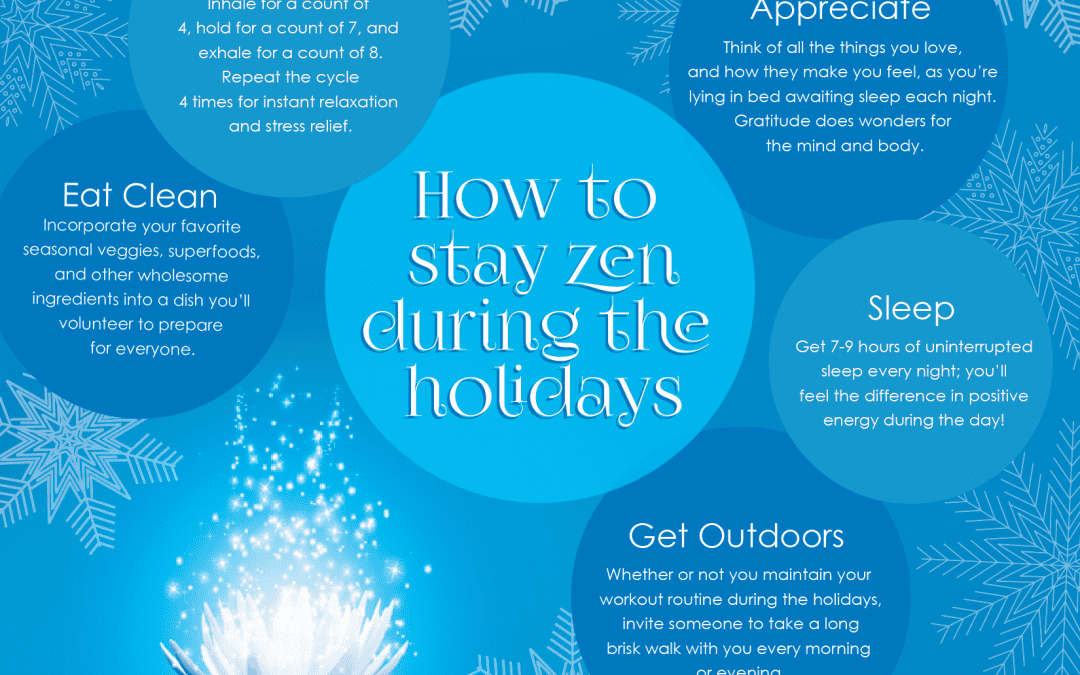5 Ways to Reduce Holiday Stress
The holiday seasonal stress is particularly challenging for people with chronic pain conditions like fibromyalgia and migraine, since stress can exacerbate pain.
If you suffer from chronic pain here are five tips to help you manage your stress and pain levels during the holidays:
Reduce Holiday Stress
1. Set your priorities
There’s a lot demanding your time and attention at this time of year. Don’t feel pressured to do it all. Take a minute to think about which holiday activities mean the most to you, and focus on those.
2. Take time for yourself
With busy holiday schedules, people often forget to take breaks. Consider scheduling time for yourself to do something relaxing and enjoyable. Especially if the holidays are emotionally difficult of you, it’s important to take care of yourself and seek support when needed. Journal – Breathe- take a power nap.
3. Exercise
In addition to easing stress, exercise has been shown to reduce the frequency and duration of migraines, as well as lessen the pain and disability of fibromyalgia, sciatica, and whiplash. Exercise can also speed the recovery time of many pain conditions and injuries. Your chiropractor can help you find safe, effective ways to help you keep your energy level up.
4. Be mindful of your nutrition:
The holidays are full of food and drinking temptations. While it’s okay to indulge yourself in moderation, over eating or eating from stress can make you feel worse in the end. Developing a healthy eating plan and getting adequate levels of vitamin C and Omega 3 fatty acids can help your body’s response to stress. Your chiropractor can advise you on healthy eating habits and nutrition.
5. Chiropractic Adjustments:
Finally, chiropractic itself can help you manage your pain and stress level. In fact, a research study in 2010 showed that chiropractic adjustments helped reduce levels of cortisol, a stress hormone known to cause inflammation and irritation.
This holiday season, remember you don’t need to suffer from pain and stress.
Albert, HB and C. Manniche. “The efficacy of systematic active conservative treatment for patients with severe sciatica.: A single-blind randomized clinical controlled trial.â€Â Spine (April 2011). doi: 10.1097/BRS.0b013e31821ace7f.
Brooks, Megan. “Exercise may offer drug-free migraine prevention.†Reuters. October 7, 2011. Accessed October 10, 2011. http://www.reuters.com/article/2011/10/07/us-exercise-headaches-idUSTRE7966C920111007.
Olaya-Contreras, Patricia. “ Biopsychosocial analyses of acute and chronic pain, especially in the spine: The effect of distress on pain intensity and disability.†Institute of Clinical Sciences at the Sahlgrenska Academy University of Gothenburg. 2011.Â
Panton LB, Figueroa A, Kingsley JD, et al. “Effects of resistance training and chiropractic treatment in women with fibromyalgia.†Journal of Alternative and Complementary Medicine 15.3 (2009): 321-328.
Pedler, Ashley and Michele Sterling. “Assessing Fear-Avoidance Beliefs in Patients With Whiplash-associated Disorders: A comparison of 2 measures.†Clinical Journal of Pain 27.6 (2011): 502-7.
Delaure J. et al. “Fish oil prevents the adrenal activation elicited by mental stress in healthy men.†Diabetes and Metabolism 29.3 (2003): 289-295.
“Vitamin C: Stress Buster.â€Â Psychology Today. April 25, 2007. Accessed December 13, 2011. h
Padayachy K, Hoosen G, Vawda M. The immediate effect of low back manipulation on serum cortisol levels in adult males with mechanical low back pain. Clinical Chiropractic. December 2010. 13(4).
- Tags: chiropractic, chronic pain, fibromyalgia, holiday, low back pain, nutrition, sciatica, stressBe active: If on Vacation for the Holidays- pack your SneakersRetrieved December 18, 2019 from: www.wellnesstoday.com
[gravityform id=”1″ title=”true” description=”


Recent Comments